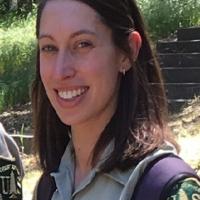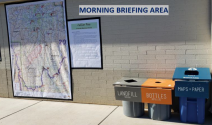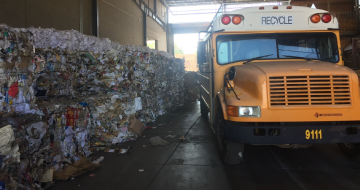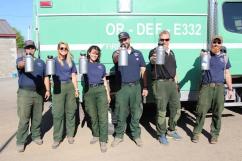Summer/Fall 2019; Volume 3
Message from Greening Fire Team Leadership
Sustainable Operations/Co-Climate Change Coordinator Lara Buluc (USFS R5) and Cooperative Fire Program Manager/Prevention Coordinator Dennis Fiore (USFS R9)
As wildfires increase in frequency and severity, the resources required to support such fires also increase. Such resources are generally thought of in terms of inputs (human capital, funding, and equipment), but it also important to consider the downstream outputs, such as solid waste.
For more than a decade, the National Greening Fire Team has supported the goal of reducing incident resource consumption.
This fire year, we have a unique opportunity to leverage two new tools that will foster innovation and promote operational and resource efficiency:
- Department of Energy National Renewable Energy Laboratory report Opportunities for Energy, Water, and Waste Reduction at U.S. Forest Service Fire Camps
Incident response is a multi-organizational effort spanning jurisdictions, agencies, and sectors. Similarly, reduction in the operational footprint of incidents will require support from all who serve.
We look forward to hearing from those who tested sustainability measures this fire season.
Statistics
- 3,138 – The number of Hydro Flasks distributed to on-the-ground firefighters in the USDA Forest Service Pacific Northwest Region (Oregon and Washington).
- 200 – The minimum number of incident personnel required for contracting incident recycling services via the On-site Incident Recycling Blanket Purchase Agreement.
- 46% – The average waste diversion rate at Southwest area incidents that utilized the On-site Incident Recycling Blanket Purchase Agreement (year-to-date).
Recruiting Interagency Greening Fire Team “Ambassadors!”
The National Greening Fire Team serves an interagency mission but has largely been comprised of Forest Service employees. We’re eager to onboard “Ambassadors” from inside (and especially outside) the agency.
What is an “Ambassador?” Glad you asked! “Ambassadors” are not formal Greening Fire Team members, with deliverables and salary funding to cover part of their time. Rather, “Ambassadors” are individuals with a keen interest in advancing sustainable business operations throughout the fire organization. They receive periodic emails, including the Quarterly Highlights Bulletins, and are invited to one or two team update webinars each year.
When possible, they are asked to apply information or products developed by the team, such as the onsite incident recycling Blanket Purchase Agreement.
If you are interested in being a Greening Fire “Ambassador” contact the Greening Fire Team.
Contact Us
Interested in learning more about the Greening Fire Team? Have questions about any of the stories in this bulletin? If so, contact the Greening Fire Team.
Links of Interest
Spotlight
Resource Information Specialist Carly Gibson, Stanislaus National Forest
Describe the sustainability advocacy efforts that you have undertaken in your position with the USDA Forest Service and in your role on fire incidents.
Sustainability is a way of life for me, so my efforts are mostly just being myself and including a little bit of information in casual conversations. Some of my co-workers are simply curious about why I wrap my burrito in a cloth napkin or work with the lights off. That can be all it takes to inspire behavioral changes.
A few years ago, my unit received a Sustainable Operations Microgrant from the Regional Office to establish recycling at all of our offices. I worked with folks on every unit to set up a simple recycling system using buckets. The employee association recycles California Redemption Value -eligible items, and the proceeds are used to support our staff and boost morale. This is important to maintain motivated and happy employees across the Forest. Not all offices are able to participate in the recycling program, but all offices benefit from the ones that do.
In the context of fire incidents, I keep the conversation going with my colleagues; in addition, I work with a cadre of Resource Advisors (READ) pre-season. The READs are local forest employees from various program areas. This spring, we worked on several Standard Operating Procedures for incidents, including weed washing and recycling. We presented those to our Forest Leadership Team, gained approval, and prepared all of the forest READs to implement the new procedures on incidents.
The Stanislaus National Forest consists of four Districts and one Supervisor’s Office, all of which have very robust and active READ and Burned Area Emergency Response programs. The timing of the multi Geographic Area Coordination Center on-site incident recycling Blanket Purchase Agreement was helpful in gaining support from our leadership. Working together spreads the labor and holds us accountable to follow through. Our busy professional lives make it easy to put this work on the back burner, but having a group of passionate co-workers is inspiring and keeps us on task.
What motivated your sustainability efforts and desire to integrate such principles into your work?
I strive to avoid generating waste when at home or work. This is a lifestyle that I maintained prior to my Forest Service career and I continue to be motivated to live sustainable. All waste has an impact to someone else’s quality of life, economic well-being, and environment. I’m motivated to reduce my impact on communities, as well as future generations.
What do you believe are the biggest opportunities to decrease the environmental footprint of incident operations?
There are many opportunities to reduce our environmental footprint both on and off incidents! The biggest opportunity is to educate our staff about the impacts of our actions and consumption. Leadership can do a lot by making sustainable operations a priority on their units and by including sustainable operations in letters of delegation to Incident Management Teams, Wildfire Decision Support Systems, and in preseason refreshers.
Incident fuel consumption is up there with smoke emissions in terms of atmospheric impacts. Vehicles of all shapes and sizes idle in parking lots, at staging areas, and even in the middle of roads during fires. It is easy to turn off your vehicle when it is parked! We can do a better job of ride sharing, too.
Throughout my career, I have noticed an increased reliance on aircraft to manage wildfires. Agency Administrators can greatly influence a wildfire’s environmental footprint by using fire for resource benefit where appropriate, and sticking to Minimum Impact Suppression Tactics in wilderness and roadless areas, as well as places with special designations such as Research Natural Areas, Wild & Scenic Rivers, and Scenic Areas. The alternative is a lot of helicopter and aircraft use for operational tactics and transport; these are major contributors to escalating fire costs and the associated internal social and economic disparity in our agency. Aircraft are necessary to manage wildfire, but we can do a better job of recognizing the impacts that they have.
Finding ways to reduce incident food waste is another opportunity to reduce our environmental footprint. Growing, harvesting, processing, packaging, and transporting food to fire camp is an impact that we often overlook because we are extremely disconnected from our food systems. It seems appropriate to provide a light lunch option to people working in camp or between camp and the fireline. Crews need the calories that sack lunches provide, but not the folks in camp because this results in a lot of extra food. I like seeing the local food bank donation boxes in camp; that is much better than seeing all those snack items in the garbage. Pallets of water & Gatorade are one of the first supplies ordered on incidents, yet recycling those plastic bottles is not always feasible in rural areas.
The new Blanket Purchase Agreement for recycling on incidents that support more than 200 people is a huge step forward. Reducing the need for bottles is the next step. I am not sure what that looks like, but we used to use cubies all the time. I was shocked to see them being filled at the District Office earlier this month.
What challenges have you faced as a READ, or in other fire support capacities, in which sustainability efforts played a role?
The biggest challenges are the lack of awareness and the need for education and greater leadership support. The READ’s role is misunderstood. We are commonly perceived as the folks who get in the way or slow down suppression operations. Many READs are specialists who work hard year-round to protect their resources. Wildfire management is fast paced, so keeping up as a READ who is viewed as opposition rather than part of the team can be stressful. I try to put myself in their shoes.
When fire is active on any given Division, I offer my assistance while working through mitigation measures. I work with planning operations and the planning section to get ahead of on-the-ground resource protection needs. This reduces any surprises on the READ end of things and gives me the opportunity to help with local information.
Do you have a single sustainability-related achievement that you are most proud of?
Just sticking with this agency for the last 17 years is a sustainability-related achievement! I struggle to keep my chin up, especially with an increasingly shrinking experienced resource management staff across the nation. Establishing a READ Cadre on my unit with my co-workers, and following through on small and large tasks to make our jobs easier on incidents is a solid recent achievement. Any time that I can contribute to managing fire for resource benefit is probably the biggest contribution I can make.
On-site Incident Recycling Blanket Purchase Agreement – Background & Results to Date
How serious is the waste problem in America?
Recent Congressional findings published under 42 USC 6901, Title 42, Chapter 82 state that the “problems of waste disposal…have become a matter, national in scope and in concern, that necessitate Federal action…to reduce the amount of waste and non-salvageable materials.”
Furthermore, “The Congress finds with respect to the environment and health, that…alternatives to existing methods of land disposal must be developed since many of the cities in the United States will be running out of suitable solid waste disposal sites within five years unless immediate action is taken.”
Also, “The Congress finds that with respect to materials, that (1) millions of tons of recoverable material which could be used are needlessly buried each year; (2) methods are available to separate usable materials from solid waste; and (3) the recovery and conservation of such materials can reduce the dependence of the United States on foreign resources…”(Source).
What is the Forest Service doing about it?
The National Greening Fire Team is working hard to respond to the nation’s waste management challenge.
On April 17, 2019, a “Sustainable Operations in Incident Management Letter of Intent” was issued from the Acting Deputy Chiefs of National Forest Systems and State and Private Forestry. In this memo, Line Officers were requested to include expectations for implementing sustainability Best Management Practices on incidents. Additionally, Incident Management Teams were requested to leverage the On-Site Incident Recycling Blanket Purchase Agreement on Type 1 and 2 incidents. This provides on-site recycling services for the Northwest, Northern California, Southern California, and Southwest Geographic Area Coordination Centers.
Vendors are required to collect, sort, transport, and report on recyclables that are diverted from the waste stream. Standardized recycle stations must be placed at key, high-traffic locations throughout the fire camp and regularly monitored to minimize contamination while maximizing the recovery of recyclable materials.
Vendors are required to divert a minimum of 40% of the waste by focusing on “primary recyclables” including cardboard, mixed paper, plastics #1 and #2, aluminum and tin, as well as scrap wood. Incident Management Teams can elect additional, optional waste diversion services for specific, often difficult-to-manage waste streams such as batteries, cooking oil, and compost.
As part of measuring and verifying performance, the vendors are required to utilize ArcGIS Survey123 forms to document the physical volume of waste and recyclables managed on a weekly basis. Vendors are also required to provide photos and other supporting documentation to maximize the legitimacy of the program. The data is collected and displayed using an online Incident Waste Diversion Dashboard.
And the Results?
To date, recycling services have been ordered from the Blanket Purchase Agreement on eight (8) Type 1 and 2 fires in the Southwest,
Northwest, and northern California Geographic Areas. In the Southwest, recycling vendors were able to divert, on average, 46% of the waste that would have otherwise been hauled to community landfills. In the Northwest and northern California, recycling vendors averaged a waste diversion rate of 49% and 43%, respectively. Waste diversion results are updated weekly on the online Incident Waste Diversion Dashboard.
On the Cellar Fire near Mayer, AZ, the incident recycling vendor reduced dumpster servicing fees by an estimated 50%-75%. As shown below, the vendor was able to remove half of the waste from the trash roll-off. This effort reduced the frequency and cost associated with hauling trash receptacles to the local landfill. Rather than establishing and paying for a “routine” dumpster service multiple times per week, the Logistics Team shifted the trash service to an “as needed” basis. Trash was picked up only when the roll-off was full.
This approach enables a higher degree of cost-containment related to waste management on incidents while also reducing the agency’s impact on community landfills.
What’s New with the Greening Fire Team Website?
In late April 2019, the National Greening Fire Team transitioned its public-facing website from the National Wildfire Coordinating Group Logistics Subcommittee’s portal to that of USDA Forest Service Fire & Aviation Management. This transition directly reflects the desire for sustainability considerations to be integrated within the framework of the agency’s Fire program and response. The goal of the new website is to provide a forward-facing, interactive, “one-stop shop” for content related to sustainable operations best management practices for fire incidents.
We strive to keep the website relevant by continuously updating and providing the most current information. As you navigate the site, notice hotlinks within the Related Content box on the lower left side of each page. These resources will help you learn more about the team’s many facets. Here are a few quick links to get you started:
- What You Need to Know in 2019
- Meet the Greening Fire Team & Become an Ambassador
- Tools and Resources
- Incident Recycling Overview
- Incident Recycling BPA Implementation Quick Guide
National Greening Fire Team and Hydro Flask Partner to Promote Zero Waste and Wellness
As part of the National Greening Fire Team’s ongoing efforts to achieve net zero waste by 2030, the team partnered with Hydro Flask to provide durable, reusable water bottles at incidents in the Pacific Northwest Region (Oregon and Washington).
This mutually beneficial partnership provided 3,365 64-ounce flasks at a discounted rate to support local firefighters near the company’s headquarters in Bend, OR. This action helped reduce single use plastic on incidents while helping to keep firefighters hydrated, contributing to their overall safety and wellness.
As of August 2019, 3,138 of the flasks had been directly distributed to “on-the-ground” firefighters at each of the Pacific Northwest Region Administrative Units. The remaining 227 flasks will be directed to the first large incident supported by the Northwest Area Cache this fire year.
Share Your Greening Fire Successes and Lessons Learned from this Fire Year!
Have you led or supported efforts to reduce the environmental impact of incidents this fire year? Do you have a USDA Forest Service computer profile? If so, you are well-positioned to document your experience in the Leadership in Sustainable Operations portal. All who are striving to live more sustainable are encouraged to enter brief success stories or lessons learned in the Sustainability Stories portal [internal link]. Along with highlighting your good work, these stories are used to report to senior leadership and oversight agencies.












